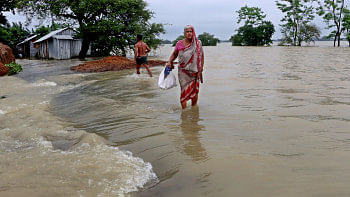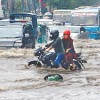Kalidas’s Meghdoot and Bangladesh’s monsoon reality

It is not unusual for us to experience an intense sense of nostalgia and longing for our loved ones as the monsoon clouds roll in and the first raindrops touch the ground. Much like in Kalidas's acclaimed Sanskrit poem "Meghdoot" where on the first day of the monsoon, Yaksha felt a desperate longing to reach his distant wife.
The myth follows Yaksha, who was banished by his master Kuber to the remote Ramgiri mountain for neglecting his duties, separated from his beloved wife. In yearning for her, Yaksha sees thick clouds drifting towards north on the first day of the month Ashar and appeals to a passing cloud to deliver a message to his wife in the faraway city of Alaka. Thus begins "Meghdoot", with an imaginary dialogue between the Yaksha and the cloud.
Kalidas used clouds to symbolise Yaksha's hope of sending a heartfelt message to his beloved. Aside from that, their majestic presence brings joy and relief to the people suffering from the scorching summer heat, emerging as their answered prayer and announcing long awaited rain.
But monsoon in Bangladesh contrasts this idyllic portrayal. While some indulge in weather demands like khichuri or fritters with a hot cup of tea, for others—working professionals, students, or those running errands—it's a complete curse. Waterlogged streets, muddy footpaths, traffic jams, and high transport costs turn everyday tasks into a challenge. For those living in flood-prone areas near riverbanks, monsoon brings additional hardships. It becomes a period of survival, at least the recent floods in Sylhet hint so.
Which is why, although Kalidas associated monsoon clouds with concepts of nature and love, in Bangladesh, the arrival of the monsoon is now viewed with concerns because of the hardships it could cause.
Natural occurrences or debts to pay?
Throughout history, monsoon in Bangladesh has been more than just a season of rain, it is a celebrated cultural experience influencing folk songs, festivals, and agricultural practices. Historically, successful monsoon brought abundance, while a failed or weak one could even trigger famine.
Monsoon in Bangladesh has become too complex to be simply termed a "natural disaster." In recent years, it has posed increasing challenges, with Bangladesh ranking seventh on the 2021 Global Climate Risk Index, highlighting its vulnerability to climate devastation.
This predicament extends across South Asia, where scientists attribute these changes to the climate crisis, predicting stronger monsoons with more heavy rainfall ahead. But addressing these challenges requires moving beyond viewing the damages as purely natural occurrences, because that approach helps us avoid our accountability for the damages incurred. A study titled "Fourth National Climate Assessment", published by the US Global Change Research Program provides compelling evidence that human activities, notably fossil fuel burning, are the primary factors behind warming trend across the globe that is affecting climate patterns.
Colonial mindset
When we mention human activity, it is essential to acknowledge the colonial mindset that emerged after post-British rule. During the British period, the rulers saw waterways, especially the delta's changing rivers, as obstacles to management, taxation, and governance.
For over 200 years, urban development prioritised creating dry land by regulating waterways, filling up the rivers, canals, embankments, and other structures. They created maps and laws, like the Permanent Settlement Act, to clearly distinct land from water.
They constructed other infrastructure projects, to dominate the delta and increase profitability. Local influentials and natives also participated for their benefit. These actions normalised the alteration of the natural water-soaked ecology, leading people to forget and overlook the potential consequences.
Even after the British left, city and water management remained unchanged. The government continued building embankments and dams to control rivers, aiming to modernise the country. This infrastructure-focused approach overlooked the challenges of filling waterways, causing most of the monsoon struggles people experience now.
Now, the monsoon makes us wonder how the situation escalated, whereas we acknowledge that current approaches to managing water aren't really effective.
Yet the obsession with West-defined "development" continues to promise us more unplanned infrastructure projects, often supported by international organisations. Such aims overshadow questions for what the climate needs and how cities in a monsoon-fed landscape should be designed.
Environment vs economy: Who is paying the price for these developments?
The recent floods in Sylhet serve as a relevant example of the impact of forced development. These floods are happening for many reasons. Located just below Cherrapunji, known as the wettest place on Earth, Sylhet is naturally prone to significant rain. But the last two years clearly suggest that human actions too are exacerbating the situation there.
In areas like Sylhet or Sunamganj, the lands used to be different: rivers were navigable, and there were fewer roads and structures. Now, floodwaters take more time to recede. Previously, swamps and sinkholes helped contain floodwaters, but this is no longer the case.
Because every region has a capacity limit for water absorption, when rainfall exceeds this limit, flooding occurs—which has become a regular fixture in Sylhet. The hilly terrain of Sylhet historically allowed rainwater to naturally flow down from high grounds. But unplanned development, including filling water bodies and rampant illegal hill-cutting disrupted this natural balance and exacerbated flood risks, while eroding the area's geographical identity. Roads constructed across the Haor region impede water flow, while urban development prevents water from permeating the ground.
While flooding can be natural, waterlogging primarily stems from human errors and negligence. Unplanned infrastructure that fills up the waterways, leaving no natural pathways for water, makes for inadequate drainage systems, compounded by additional plastic pollution.
We cannot, anymore, imagine monsoon without waterlogging, especially in Dhaka, despite ongoing promises from local authorities to resolve the issue. Responsibility has shifted from WASA to the city corporations, with hundreds of crores spent on drainage projects. However, the heavy rainfall continues to cause severe waterlogging due to inadequate drainage systems, blocked catch pits, plastic pollution, and outdated infrastructure.
Even in Chattogram, moderate to heavy rainfall is enough to inundate residential areas, main roads, lanes, and by-lanes across both the old and new parts of the city, notably because of defiance of a 1995 drainage master plan, hasty project implementations without feasibility studies, and the filling of 70 percent of water bodies for construction purposes and more.
Landslides in Bangladesh from 2000 to 2022 have caused 727 deaths, including 54 children, and 1,017 injuries. Historical records of landslide events indicate an average of 19 landslides annually in the country, with a four percent increase each year.
The never-ending saga of the Teesta treaty
The management of international rivers like Teesta and Ganga, particularly the opening of the Farakka and Teesta barrage gates during heavy rains and upstream water flow from India, has caused ongoing damages and hardships for the people of Bangladesh. These rivers are governed by the United Nations' International River Convention of 1997, which establishes rules for their shared use.
According to Article 7.2 of the convention, if significant harm is caused to another watercourse state, the state responsible must consult with the affected state, taking effective measures to eliminate or mitigate the harm. This includes discussing compensation where appropriate. Bangladesh retains the right to seek compensation for damages resulting from upstream projects affecting these rivers.
But each time, hopes for progress on the Teesta treaty are dashed by West Bengal's objections and India's extensive irrigation use of Teesta's water, similarly to the Ganges and the Farakka barrage.
Many believe that negotiation with India could be pivotal—a collaborative approach to managing shared rivers rather than unilateral diversions. However, decolonising the idea of development should be taken seriously as well. This involves rethinking infrastructure priorities, emphasising highly on the waterways and their natural flow, focusing on resilient and sustainable solutions, investing in robust drainage systems capable of handling monsoon deluges and providing early warning systems to mitigate disaster risks. Moreover, safeguarding vulnerable communities living in flood-prone areas and ensuring their shelter and safety must be prioritised in urban planning and development.
As we revel in the cozy comforts of a monsoon at home, we experience a modern interpretation of Kalidas's poetic vision. In "Meghdoot", clouds conveyed messages of love. But today, our clouds carry concerns about the severity of each year's monsoon. What we often term as "development" can backfire when the rains arrive, leading to flooded streets, precarious landslides, and a reminder that our monsoon has become more about survival than celebration.
Ayesha Humayra Waresa is a freelance writer.
Views expressed in this article are the author's own.
Follow The Daily Star Opinion on Facebook for the latest opinions, commentaries and analyses by experts and professionals. To contribute your article or letter to The Daily Star Opinion, see our guidelines for submission.

 For all latest news, follow The Daily Star's Google News channel.
For all latest news, follow The Daily Star's Google News channel. 











Comments